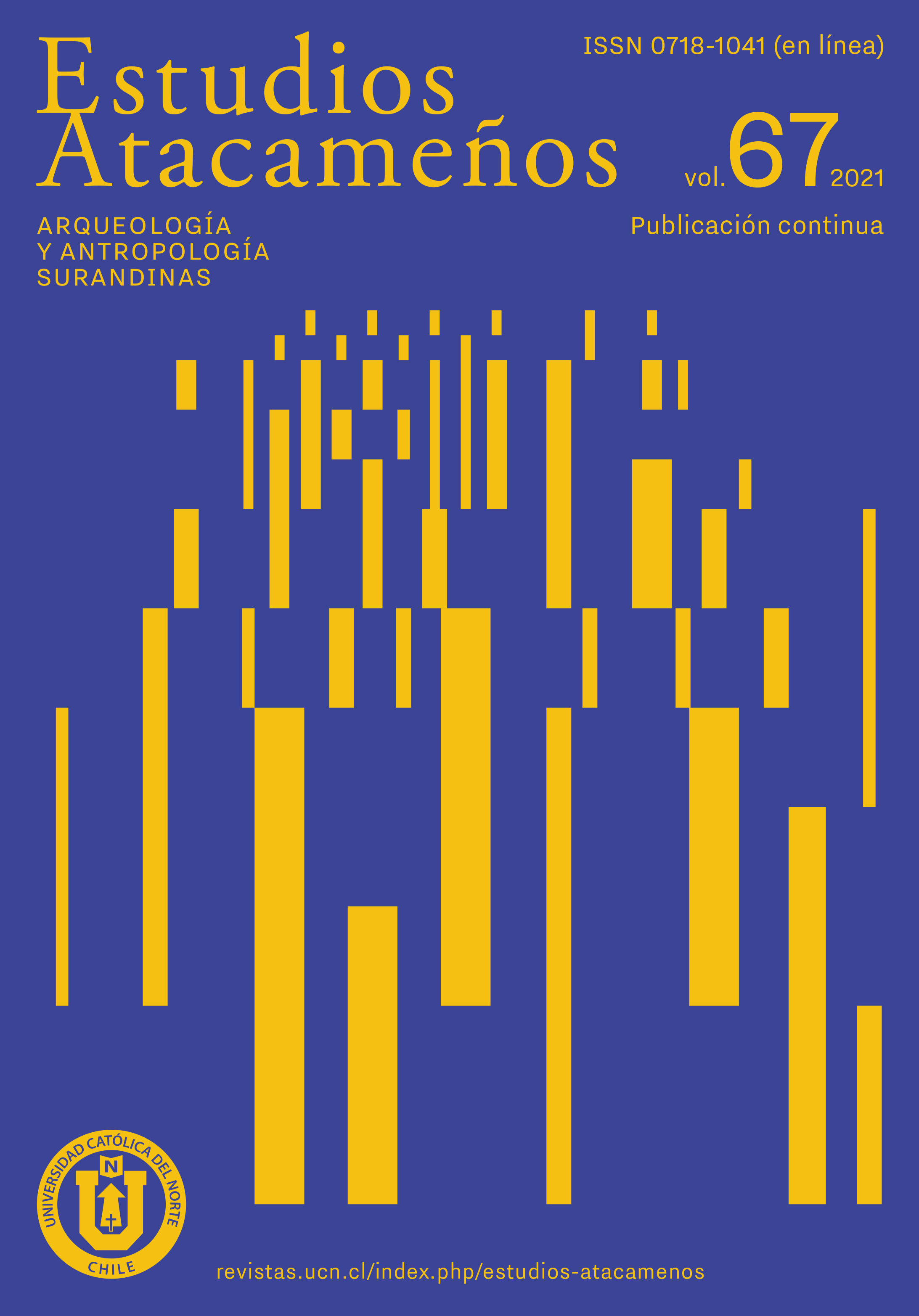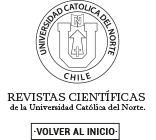Agriculturization
The alquimia of a Kañari pre-columbian landscape in the upper basin of the Chanchán River, Andes of Ecuador
DOI:
https://doi.org/10.22199/issn.0718-1043-2021-0011Keywords:
agrarian landscape, pre-Columbian agriculture, Kañari culture, agricultural societies, Equatorial AndesAbstract
Although the importance of agriculture as a key factor in the economic development of Andean peoples and territories has been widely recognized worldwide, there have been few attempts to assess its historical importance in the construction of pre-Columbian agricultural landscapes in the Andes of Ecuador. This article presents the first results of the analysis of the Kañari agrarian landscapes in the upper Chanchán basin, showing a long historical trajectory that spanned almost 2000 years from the Late Formative Period (543-381 cal BC) to the final phase of the Integration Period (1386-1438 cal AD). Extensive and intensive farming systems (permanent fields and terraces) acted as a transforming agent of the space, imprinting an agro-sacralized cultural signature with the configuration of three types of landscapes: Domestic, Social and Sacred. The agriculturization of these landscapes shows how the intensification of agriculture under a unilinear progression model does not generally mean a natural retreat of ecosystem processes, due to human intervention for the production of its crops. The elasticity of the pre-Hispanic Kañaris agroecosystems could be sustained in the face of the historical processes of agriculturization throughout its historical trajectory.
Downloads
References
Aguirre, M. (2009). Excavaciones en los andenes de Andamarca, cuenca del río Negromayo, Lucanas, Ayacucho. Arqueología y Sociedad, 20, 223-268.
Aguirre, C., Carrasco, J. y Chávez, C. (2018). Arqueología del Pukara del Puñay: 775-1390 cal. d.C. Quito: Caracola Editores.
Alcina, J. (1981). Fechas radiocarbónicas en la arqueología del Ecuador. Revista española de antropología americana, 11, 95-102.
Altieri, M. (2002). Agroecología: bases científicas para una agricultura sustentable. Agropecuaria; AS-PTA.
Alwang, J., Norton, G. W., Barrera, V. y Botello, R. (2013). Conservation agriculture in the Andean highlands: Promise and precautions. En The future of mountain agriculture (pp. 21-38). Berlin, Heidelberg: Springer.
Anschuetz, K., Wilshusen, R. y Scheick, C. (2001). Una arqueología de los paisajes: perspectivas y tendencias. Journal of Archaeological Research, 9(2), 152-157.
Arkush, E. (2012). Los Pukaras y el poder: Los collas en la cuenca septentrional del Titicaca. En Flores, L. y Tantaleán, H. (Eds.). Arqueología de la Cuenca del Titicaca (pp. 295-320). Lima: Institut français d’études andines.
Arkush, E. e Ikehara, H. (2019). Pucarani: Defensive monumentality and political leadership in the late pre-Columbian Andes. Journal of Anthropological Archaeology, 53, 66-81. doi:10.1016/j.jaa.2018.11.002
Ashmore, W. (2002). Decisions and dispositions: Socializing spatial archaeology. American Anthropologist, 104(4), 1172-1183. doi:10.1525/aa.2002.104.4.1172
Ashmore, W. (2004). Social archaeologies of landscape. A companion to social archaeology, 255-271.
Athens, J. (1978). Evolutionary Process in Complex Societies and the Late Period-Cara Occupation of Northern Highland Ecuador. Ph.D. dissertation, Department of Anthropology, University of New Mexico, University Microfilms, Ann Arbor.
Athens, J. (1980). El proceso evolutivo en las sociedades complejas y la ocupación del periodo tardío-Cara en los Andes septentrionales del Ecuador. Vol. 2. Otavalo: Instituto Otavaleño de Antropología.
Athens, J. (1990). Prehistoric agricultural expansion and population growth in northern highland Ecuador: interim report for 1989 fieldwork. International Archaeological Research Institute.
Athens, J. (2003). Inventory of earthen mound sites, Northern Highland Ecuador. Manuscript on file. Quito: National Institute of Cultural Patrimony.
Athens, J. (2012). El Sitio Tola de la Hacienda Zuleta: Investigaciones 2010. Manuscript on file, National Institute of Cultural Patrimony, Quito.
Bar-Yosef, O. (2017). Multiple origins of agriculture in Eurasia and Africa. En On human nature (pp. 297-331). London: Academic Press.
Bathurst, J., Iroumé, A., Cisneros, F., Fallas, J., Iturraspe, R., Novillo, M. y Cisneros, P. (2011). Forest impact on floods due to extreme rainfall and snowmelt in four Latin American environments 1: Field data analysis. Journal of Hydrology, 400(3-4), 281-291. doi:10.1016/j.jhydrol.2010.11.044
Bennett, W. C. (1946). Excavations in the Cuenca region, Ecuador (No. 35-36). New Haven, CT: Published for the Department of Anthropology, Yale University by Yale University Press.
Binford, L. (2019 [2001]). Constructing frames of reference: an analytical method for archaeological theory building using ethnographic and environmental data sets. University of California Press.
Bonomo, M., Skarbun, F. y Bastourre, L. (2019). Subsistencia y alimentación en arqueología. Libros de Cátedra. Buenos Aires: Universidad Nacional de La Plata.
Bonzani, R. M. y Oyuela-Caycedo, A. (2006). The gift of the variation and dispersion of maize: Social and technological context in Amerindian societies. En Staller, J.E., Tykot, R. H., Benz, B. F. (Eds.). Histories of Maize: Multidisciplinary Approaches to the Prehistory, Biogeography, Domestication, and Evolutions of Maize (pp. 343-356). Burlington, MA: Left Coast Press.
Boserup, E. (1965). The conditions of agricultural growth: the economics of agrarian change under populations pressure. London: George Allen y Unwin.
Bray, T. (2005). Multi-ethnic settlement and interregional exchange in Pimampiro, Ecuador. Journal of Field Archaeology, 30(2), 119-141. doi:10.1179/009346905791072369
Bray, T. (2008). Late Pre-Hispanic chiefdoms of highland Ecuador. En Silverman, H. e Isbell W. (Eds.). Handbook of South American Archaeology (pp. 527-543). New York, NY: Springer.
Bray, T. y Echeverría, J. (2016). Las tolas perdidas de Caranqui y su contexto histórico y regional. Antropología Cuadernos de investigación, 16, 131-152. doi:10.26807/ant.v0i16.29
Brown, D., Camino, B. y Willis, M. (2008). All Quiet on the Western Frontier? Inka Fortresses of Western Highland Ecuador. En Annual Meeting of the Society for American Archaeology. Vancouver.
Bruhns, K., Burton, J. y Miller, G. (1990). Excavations at Pirincay in the Paute Valley of southern Ecuador, 1985–1988. Antiquity, 64(243), 221-233. doi:10.1017/S0003598X00077838
Butzer, K. (2007). Arqueología, una ecología del hombre: método y teoría para un enfoque contextual. Barcelona: Edicions Bellaterra.
Caillavet, C. (2008). A Native American System of Wetland Agriculture in Different Ecosystems in the Ecuadorian Andes (15th-18th Centuries). Environment and History, 331-353.
Chilon, E. (1997). Estudio de Terrazas Precolombinas Taqanas, Quillas y Wachus. La Paz: Ediciones CIDAT.
Cieza de León, P. (1984 [1553]). Crónica del Perú. Historiadores Primitivos de Indias, 2, 349-458.
Cobo B. (1890 [1613]). Historia del Nuevo Mundo. Vol. 91. Sevilla: Imprenta de E. Rasco.
Collier, D. y Murra, J. (1943). Survey and excavations in southern Ecuador. Publications of the Field Museum of Natural History. Anthropological Series, 35, 1-108.
Contreras, D. (2010). Landscape and Environment: Insights from the Prehispanic Central Andes. Journal of Archaeological Research, 18(3), 241-288. doi:10.1007/s10814-010-9038-6
Cueva, F. (2007). Las antiguas plantaciones de Chilmá: Estudio arqueobotánico sobre la agricultura de un yacimiento pasto. Tesis de Pregrado, Pontificia Universidad Católica del Ecuador, Quito, Ecuador.
De Gaviria, M. (1965) [I582]. Relación geográfica de Santo Domingo de Chunchi. En Relaciones geográficas de Indias. Vol. 2 (pp. 234-236). Madrid: Ediciones Atlas.
Denevan, W. (1995). Prehistoric agricultural methods as models for sustainability. Advanced Plant Pathology, 11, 21-43.
Denevan, W. (2001). Cultivated landscapes of native Amazonia and the Andes. New York, NY: Oxford University Press.
Donkin, R. (1979). Agricultural terracing in the aboriginal New World. Arizona: Wenner-Gren Foundation for Anthropological Research.
Elgar, M. (2003). Anthropogenic Landscapes in the Andes: a Multidisciplinary Approach to Pre-Columbian Agricultural Terraces and Their Sustainable Use. Doctoral dissertation, University of Cambridge, Cambridge, United Kingdom.
Ellen, R. (1982). Environment, subsistence and system: the ecology of small-scale social formations. Cambridge: Cambridge University Press.
Erickson, C. (1993). The social organization of prehispanic raised field agriculture in the Lake Titicaca Basin. Research in Economic Anthropology, 7, 369-426.
Erickson, C. (2000). An artificial landscape-scale fishery in the Bolivian Amazon. Nature, 408(6809), 190-193. doi:10.1038/35041555
Erickson, C. (2018). The domesticated landscapes of the Andes. En The Andean World (pp. 29-43). New York, NY: Routledge.
Estévez, M., Oubiña, C. y Boado, F. (1997). De la arqueología simbólica del paisaje a la arqueología de los paisajes sagrados. Trabajos de Prehistoria, 54(2), 61-80. doi:10.3989/tp.1997.v54.i2.366
Evans, C. y Meggers, B. (1965). Cronología relativa y absoluta en la costa del Ecuador. Guayaquil: Casa de la Cultura Ecuatoriana, Núcleo del Guayas.
FAO (2015). Los suelos están en peligro, pero la degradación puede revertirse. Food and Agriculture Organization of the United Nations. Recuperado de http://www.fao.org/news/story/es/item/357165/icode/
Fisher, C. (2019). Archaeology for Sustainable Agriculture. Journal of Archaeological Research, 1-49. doi:10.1007/s10814-019-09138-5
Fresco, A. (1984). La arqueología de Ingapirca (Ecuador): costumbres funerarias, cerámica y otros materiales. Comisión del Castillo de Ingapirca.
Gept, P. (2014). Domestication of plants. En Encyclopedia of Agriculture and Food Systems. Vol. 2 (pp. 474-486). San Diego, CA: Elsevier.
Giblin, J. D. y Fuller, D. Q. (2011). First and second millennium a.d. agriculture in Rwanda: archaeobotanical finds and radiocarbon dates from seven sites. Vegetation History and Archaeobotany, 20(4), 253-265.
Gómez, J. (1965) [1582]. Relación geográfica de Cuenca. En Relaciones geográficas de Indias. Vol. 2 (pp. 229-234). Madrid: Ediciones Atlas.
Harlan, J. (1992). Crops and man. 2nd edn. Madison, WI: American Society of Agronomy, Inc. and Crop Science Society of America.
Harris, D. (2007). Agriculture, cultivation and domestication: exploring the conceptual framework of early food production. En Denham, T., Iriarte, J. y Vrydaghs, L. (Eds.). Rethinking agriculture. Archaeological and ethnoarchaeological perspectives (pp. 16-35). Walnut Creek, CA: Left Coast Press.
Harris, D. y Fuller, D. (2014). Agriculture: definition and overview. En Encyclopedia of global archaeology, 104-113. New York, NY: Springer.
Hatch, M. (1993). Análisis de la cerámica: metodología vajilla. En Tercer Simposio de Investigaciones Arqueológicas (pp. 1-16). Guatemala: Museo Nacional de Arqueología y Etnología.
Hegmon, M. (1998). Technology, style, and social practices: archaeological approaches. En The archaeology of social boundaries, (pp. 264-279). Washington D.C.: Smithsonian Institution Press
Hogg, A., Hua, Q., Blackwell, P., Niu, M., Buck, C., Guilderson, T.,… y Turney, C. (2013). SHCal13 Southern Hemisphere calibration, 0-50,000 years cal BP. Radiocarbon, 55(4). 1889-1903
Idrovo, J. (2000). Tomebamba. Arqueología e historia de una ciudad imperial. Cuenca: Ediciones del Banco Central del Ecuador.
Idrovo, J. (2004). Aproximaciones a la historia antigua de la bio-región del Chanchán. Quito: América Latina Impresiones.
Idrovo, J. (2007). Ayllus, barrios y parroquias en la historia urbana de Cuenca. En Libro de Oro I. Municipalidad de Cuenca en conmemoración de los 450 años de la fundación española de la ciudad de Cuenca (pp. 87-93). Cuenca: Libri Mundi.
Idrovo, J. y Almeida, N. (1977). La cerámica en Ingapirca. Cuenca: Comisión de Ingapirca.
Instituto Nacional de Patrimonio Cultural del Ecuador (INPC). (2010). Registro de yacimientos arqueológicos de la provincia de Chimborazo. Riobamba: INPC Regional Zonal 3.
Instituto Nacional de Patrimonio Cultural (INPC). (2014). Instructivo para fichas de registro e inventario: Bienes arqueológicos. Quito: Ediecuatorial.
Isaacson, J. (1987). Volcanic activity and human occupation of the Northern Andes: the application of tephrostratigraphic techniques to the problem of human settlement in the Western Montaña during the Ecuadorian Formative. Doctoral dissertation, University of Illinois at Urbana-Champaign.
Italiano, H. (1965) [1582]. Relación geográfica de San Pedro de Alausí. En Relaciones geográficas de Indias. Vol. 2 (pp. 236-238). Madrid: Ediciones Atlas.
Jadán, M. (2010). Estudio de la segunda etapa de investigación arqueológica del cerro Puñay, provincia de Chimborazo. Riobamba: Instituto Nacional de Patrimonio Cultural.
Jara, H. (2007). Tulipe y la cultura Yumbo: arqueología comprensiva del subtrópico quiteño. Quito: Trama.
Jaramillo, M. (1976). Estudio histórico sobre Ingapirca. Cuenca: Pontificia Universidad Católica del Ecuador.
Kendall, A. (2013). Applied archaeology in the Andes: The contribution of pre-Hispanic agricultural terracing to environmental and rural development strategies. Humans Environ. New Archaeol. Perspect. Twenty-First Century, 153-169. Oxford: Oxford University Press.
Kendall, A. y Rodríguez, A. (2009). Infraestructura agrícola antigua y su sostenibilidad en la sierra y el altiplano sur. Desarrollo y perspectivas de los sistemas de andenería de los andes centrales del Perú (pp. 51-74). Cuzco: Institut Français d’Études Andines.
Kim, H., Bone, C. y Lee, G. (2020). Landscapes shared by visibility: a case study on the settlement relationships of the Songgukri culture, Korea. Archaeological and Anthropological Sciences, 12(2), 42. doi:10.1007/s12520-019-00987-1
Lara, C. (2010a). Delimitación e investigación de sitios arqueológicos monumentales en el valle del río Cuyes. Revista del Patrimonio Cultural del Ecuador, 2. Quito: INPC.
Lara, C. (2010b). La complejidad social en las estribaciones andinas orientales durante el período pre-incaico tardío. Antropología Cuadernos de investigación, 9, 77-90. doi:10.26807/ant.v0i9.66
Lara, C. (2016). Traditions céramiques et occupation précolombienne du piémont oriental des Andes équatoriennes: le cas de la vallée du fleuve Cuyes. Tesis de Doctorado, Université de Paris Ouest Nanterre La Défense, Nanterre.
Lara, C. (2019). Tacalshapa y Cashaloma: perspectivas del enfoque tecnológico. Revista de Historia, Patrimonio, Arqueología y Antropología Americana, 1, 180-199.
Lee, R. (1990). Primitive communism and the origin of social inequality. Cambridge: Cambridge University Press.
Londoño, A., Williams, P. y Hart, M. (2017). A change in landscape: Lessons learned from abandonment of ancient Wari agricultural terraces in Southern Peru. Journal of environmental management, 202, 532-542. doi:10.1016/j.jenvman.2017.01.012
Mantha, A. (2009). Territoriality, social boundaries and ancestor veneration in the central Andes of Peru. Journal of Anthropological Archaeology, 28(2), 158-176. doi:10.1016/j.jaa.2009.02.002
McClatchie, M. y Smith, C. (2014). Archaeobotany of agricultural intensification. Bulletin of Sumarian Agriculture, 1, 114-52.
Meillassoux, C. (1977). Mujeres, graneros y capital. México: Siglo XXI Editores.
Meyers, A. (1998). La tradición Tacalshapa y la arqueología del Cañar y Azuay en la sierra sur del Ecuador. Una secuencia a base de comparaciones con el norte del Perú. Bonner Amerikanistische Studien, 169-199.
Ministerio del Ambiente del Ecuador (2013). Sistema de clasificación de los ecosistemas del Ecuador continental. Quito: MAE.
Nanavati, W., French, C., Lane, K., Oros, O. y Beresford-Jones, D. (2016). Testing soil fertility of Prehispanic terraces at Viejo Sangayaico in the upper Ica catchment of south-central highland Peru. Catena, 142, 139-152. doi:10.1016/j.catena.2016.03.007
Navarrete, M., Gallopín, G., Blanco, M., Díaz-Zorita, M., Ferraro, D., Herzer, H., ... y Piñeiro, M. (2005). Análisis sistémico de la agriculturización en la pampa húmeda argentina y sus consecuencias en regiones extra pampeanas: sostenibilidad, brechas de conocimiento e integración de políticas. Buenos Aires: CEPAL.
Ontaneda, S. (2010). Las antiguas sociedades precolombinas del Ecuador. Quito: Ed. BCE.
Pagán-Jiménez, J., Guachamín, A., Romero, M. y Constantine, A. (2016). Late Ninth Millennium B.P. Use of Zea mays L. at Cubilán Area, Highland Ecuador, Revealed by Ancient Starches. Quaternary International, 404, 137-155. doi: http://dx.doi.org/10.1016/j.quaint.2015.08.025.
Papantoniou, G. y Vionis, A. K. (2017). Landscape archaeology and sacred space in the eastern Mediterranean: A glimpse from Cyprus. Land, 6(2), 40.
Pazmiño, E. (2014). Huataviro y los señoríos de la sierra norte del Ecuador. Revista del Patrimonio Cultural del Ecuador, 5, 56-71. Quito: INPC.
Pearsall, D. (1984). Informe del análisis de fitolitos y semillas carbonizadas del Sitio Cotocollao, Provincia de Quito, Ecuador. Manuscript on file, Department of Anthropology, University of Missouri-Columbia.
Pearsall, D. (2015). Paleoethnobotany: a handbook of procedures. New York, NY: Routledge.
Politis, G., Martínez, G. y Bonomo, M. (2001). Alfarería temprana en sitios de cazadores recolectores de la Región Pampeana (Argentina). Latin American Antiquity, 12(2), 167-181. doi:10.2307/972054
Porras, P. (1977). Fase Alausí. Revista de la Universidad Católica, 5(17), 89-160, Quito: Pontificia Universidad Católica del Ecuador.
Renfrew, C. y Bahn, P. (2008 [1991]). Archaeology: theories, methods and practice. London: Thames and Hudson.
Sánchez, C. (2015). Producción agrícola y organización política en las sociedades prehispánicas del Alto Magdalena. Revista Colombiana de Antropología, 51(2), 209-240. doi:10.22380/2539472X19
Sarmiento, G. (1986). La sociedad cacical agrícola hipótesis y uso de indicadores arqueológicos. Boletín de Antropología Americana, 13, 33-64.
Sarmiento, G. (1993). Tribus y cacicazgos arqueológicos: una discusión acerca del origen de la estratificación social. Boletín de antropología americana, 27, 95-108.
Sierra, R., Cerón, C., Palacios, W. y Valencia, R. (1999). Criterios para la clasificación de la vegetación del Ecuador. En Sierra, R. (Ed.). Propuesta preliminar de un sistema de clasificación de vegetación para el Ecuador continental. Quito: Proyecto INEFAN/GEF-BIRF y EcoCiencia.
SIGTIERRAS (2017). Mapa de Órdenes de Suelos del Ecuador. Escala 1:4 300.000. Quito: MAGAP.
Staller, J. (2006). La domesticación de paisajes: ¿Cuáles son los componentes primarios del Formativo?. Estudios Atacameños. Arqueología y Antropología Surandinas, 32, 43-57. doi:10.4067/S0718-10432006000200005
Staller, J. (2008). Pre-Columbian Landscapes of Creation and Origin. New York, NY: Springer Science & Business Media.
Tilley, C. (2006). Objectification. En Tilley, C., Keane, W., Küchler, S., Rowlands, M. y Spyer (Eds.). Handbook of Material Culture (pp. 60-73). London: Sage Publications.
Valdez, F. (1984). Les vestiges archéologiques de Sígsig, Azuay, Équateur. Un exercice d’interprétation. Tesis de Doctorado (inédita), Universidad de París X, Nanterre, Francia.
Valdez, F. (2008). Inter-zonal Relationships in Ecuador. En Silverman, H. e Isbell, W. (Eds.). Handbook of South American Archaeology (pp. 865-888). New York, NY: Springer.
Winterhalder, B. y Smith, E. (2000). Analyzing adaptive strategies: Human behavioral ecology at twenty five. Evolutionary Anthropology: Issues, News, and Reviews: Issues, News, and Reviews, 9(2), 51-72. doi:10.1002/(SICI)1520-6505(2000)9:2<51::AID-EVAN1>3.0.CO;2-7
Zeidler, J. (2008). The ecuadorian formative. In The handbook of South American archaeology (pp. 459-488). New York, NY: Springer.
Zuidema, R. (2008). The astronomical significance of ritual movements in the Calendar of Cuzco. En Pre-Columbian landscapes of creation and origin (pp. 249-267). New York, NY: Springer.
Downloads
Published
Issue
Section
License
Copyright (c) 2021 Christiam Aguirre, Jorge Córdova, Raquel Piquè

This work is licensed under a Creative Commons Attribution 4.0 International License.

All works published in Revista Estudios Atacameños (ISSN on line:0718-1043) Revista Estudios Atacameños Creative Commons International 4.0 attribution (CC BY 4.0) licence.
Authors remain the owners of their work and may republish their articles elsewhere without having to request permission, as long as they indicate that the work was originally published in Revista Estudios Atacameños (ISSN on liine:0718-1043).












